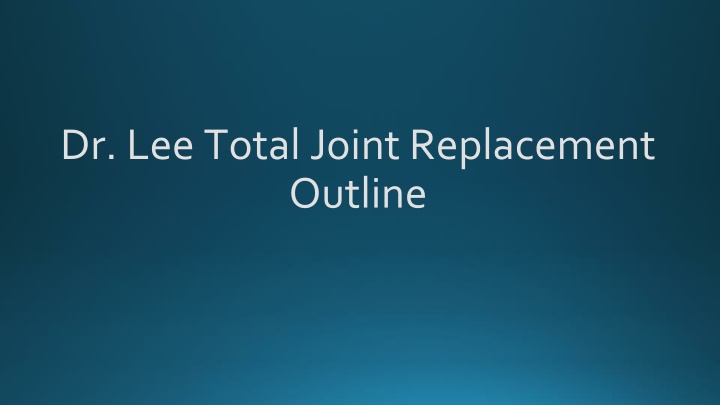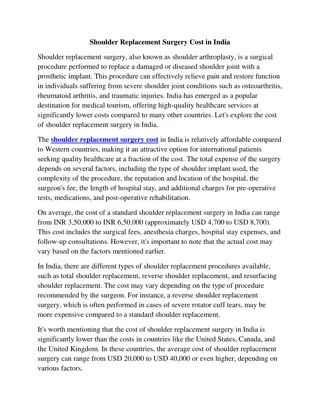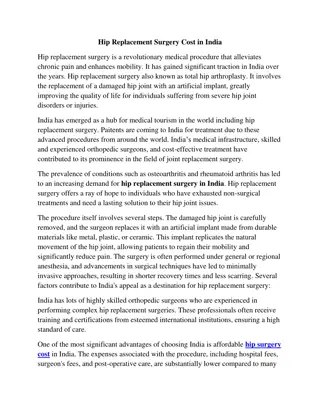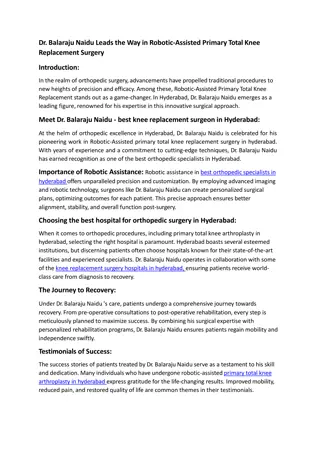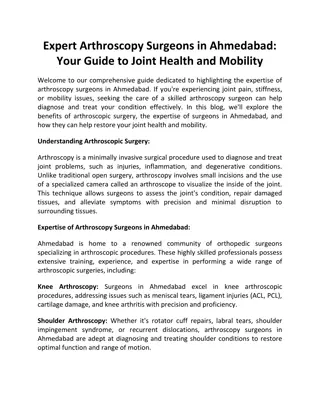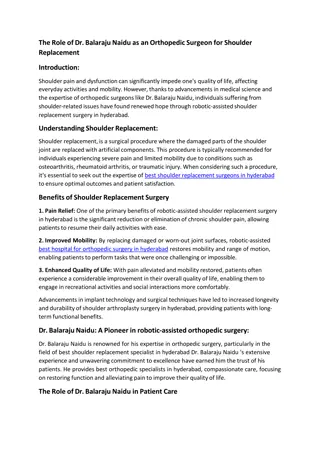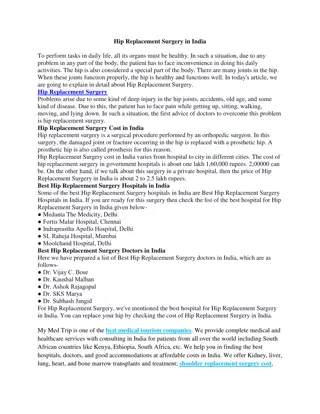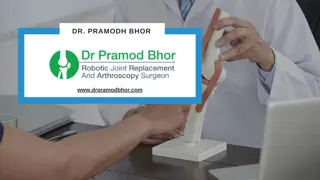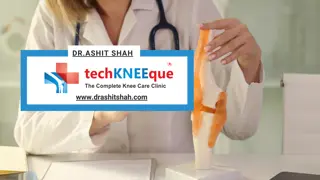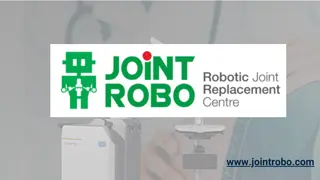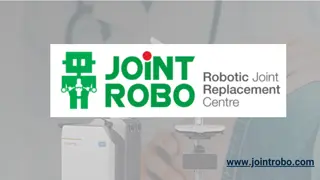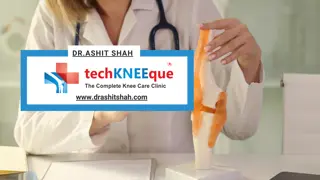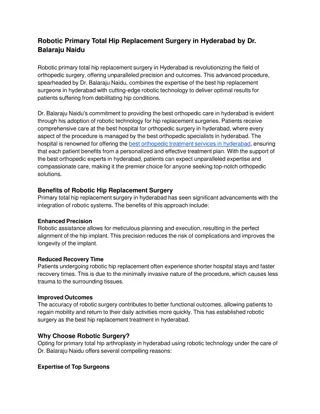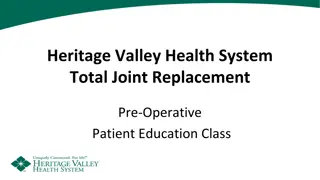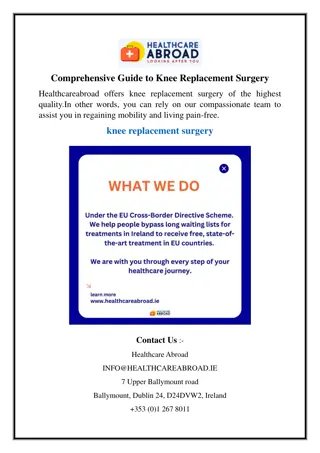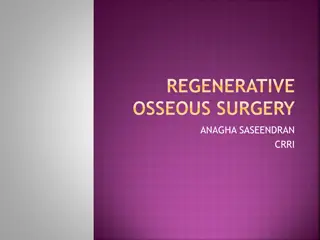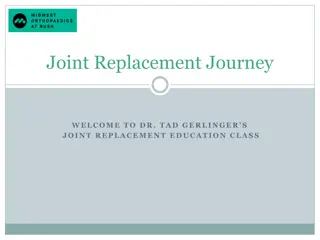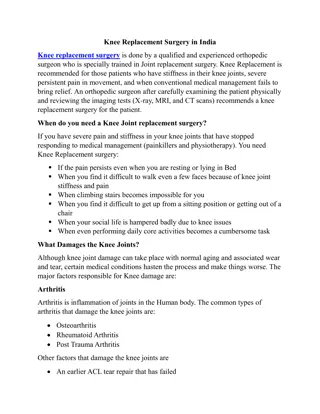Comprehensive Guide to Total Joint Replacement Surgery
This comprehensive guide provides detailed information on what to expect before, during, and after total joint replacement surgery. Covering pre-surgery preparations, day-of-surgery instructions, and post-operative care in the hospital, this outline aims to help patients navigate the entire surgical process smoothly and ensure a successful recovery.
Download Presentation

Please find below an Image/Link to download the presentation.
The content on the website is provided AS IS for your information and personal use only. It may not be sold, licensed, or shared on other websites without obtaining consent from the author.If you encounter any issues during the download, it is possible that the publisher has removed the file from their server.
You are allowed to download the files provided on this website for personal or commercial use, subject to the condition that they are used lawfully. All files are the property of their respective owners.
The content on the website is provided AS IS for your information and personal use only. It may not be sold, licensed, or shared on other websites without obtaining consent from the author.
E N D
Presentation Transcript
Dr. Lee Total Joint Replacement Outline
Introduction Purpose and intent Provide patients with information to know what to expect for upcoming surgery Prior to surgery During Surgery Post-operatively
Pre-Surgery Consider family/friend assistance for afterwards Collect Mail Care for Pets Assist at home Getting in and out of home Remove trip hazards Rugs, mats, pets Prepare meals Get non-slip mat for shower Consider purchasing an elevated toilet seat and a grasper Don t let pets lick wound or lie in your bed
Pre-Surgery No dental procedures within 1 month prior and 3 months after Begin pre-hab (upper body strength) No shaving of legs x 3 days prior to surgery Avoid constipation before surgery (fluids, fiber, exercise) Pre-op aptmt bring all meds currently taking to update chart Review workup and ensure everything is set
Day of Surgery Be flexible on day of surgery, arrive on time and be ready to possibly come in early NPO after midnight Things to bring Glasses/contact lens care Hearing Aids Dentures Insurance Card Photo ID Toiletries Loose clothing CPAP (if using at home) Current medication bottles Don t bring valuables
Day of Surgery Preop Area Change into gown IV initiation Update medical information in hospital system Pre-surgical pain medications as appropriate Anesthesia and surgical consent Surgery Spinal tetracaine General Anesthesia -ET tube or not based on anesthesia preference Surgery is 1.5-2 hrs with 30 min of preparation in OR and 15-20 min coming out of anesthesia PACU (roughly 45 min) ensure pain control, neurologic assessment and stable recovery from anesthesia On the floor Foley catheter, SCDs, TED Hose, possible drain/abduction pillow, dressings, PT/OT eval
Post op (Hospital) Average duration of stay (1-3 days) Factors affecting Health status Physical Condition Positive outlook optimism improves recovery Pain control PT/OT goals Fall Risks Narcotics, instability, blood pressure (Call nurse to get up safely) Pain management Preop meds Spinal Joint injection Ask for pain meds before pain is severe Ice Exercises/CPM Elevation
Post op (Hospital) Contd Knee positioning after a TKA 3 pillows under the ankle with nother behind the knee Get up and move Expect noise/alarm at night, vitals in the night, etc. If a problem, notify your nurse Incentive spirometry CPM PT/OT Eval Meds Narcotics, stool softener, anti-coagulant, chronic home meds, abx x 24 hrs
Post op (Home) Wound Care AquacellDressing Leave in place until post op appointment or can remove 10 days after surgery Can get wet in the shower immediately. No soaking in tubs If bleeding touches edges of white strip, remove dressing by pulling outward. Cover with sterile 4x4 s and ACE wrap. Standard Dressing Remove 72 hrs after surgery and leave open to air Can get incision wet with shower water at POD5. If draining, do daily dressing changes with sterile 4x4 and ACE wrap until no drainage x 24 hrs. Then can leave open to air. Don t get wet until 5 days after draining ceases Incisional care for all joint replacements No soaking in tub for 28 days Watch for redness, swelling, increasing pain, FAC, sutures poking through skin Notify surgeon immediately if this occurs or go to ER
Post op Physical/Occupational Therapy PT Leg exercises, walking, stairs May bring your walker from home OT ADL (dressing, bathing, etc.) Starts POD 0 or POD 1 They will help ensure a safe transition home Things to consider How hard is it to get into vehicle to go home Stairs into home and in the home See outpatient therapy of your choice within 1-2 days of discharge PT Rx will be provided at the time of discharge
Possible Complications DVT How to prevent Blood thinners post op in hospital and at home. Continue at home as prescribed SCDs in hospital TED hose for TKA and some THA (posterior approach) Signs Calf pain, increased pain above or below knee, swelling in calf ankle pain Call surgeon office or go to ER Can cause PE Suddne SOB, CP, Cough = 911
Possible Complications Contd Infection Wash hands and keep incision clean Signs fever > 101.4, increased tenderness/redness/swelling, drainage = call surgeon or 911 IV abxin hospital after surgery Maintain good dental hygiene No dental procedure 1 moprior and 3 moafter
Post Op Keys to Success Proper preparation for home life and transportation to PT appointments Be compliant with PT exercises and appointments Understand that this is not a picnic but have an optimistic outlook to overcome and succeed Do exercises and ROM at home as recommended by your PT Be mobile to help with pain, prevent DVT/pneumonia and stimulate bowels Take stool softeners with narcotics and follow bowel regimen given on discharge. This can also be found on Dr. Lee s website (www.jaredleemd.com) Use CPM 2-3 hrs per day and advance as tolerated. Try do do at least 0- 90 degrees
Activities After Surgery Activities you can do Walking Biking Hiking Golfing (full round after 6 months) Light impact cardio (stairs, elliptical, biking) Avoid to avoid High impact activities such as running, jumping, jogging, skiing Horse back riding to be determined by physician Driving can be resumed roughly 4-6 wks after surgery
